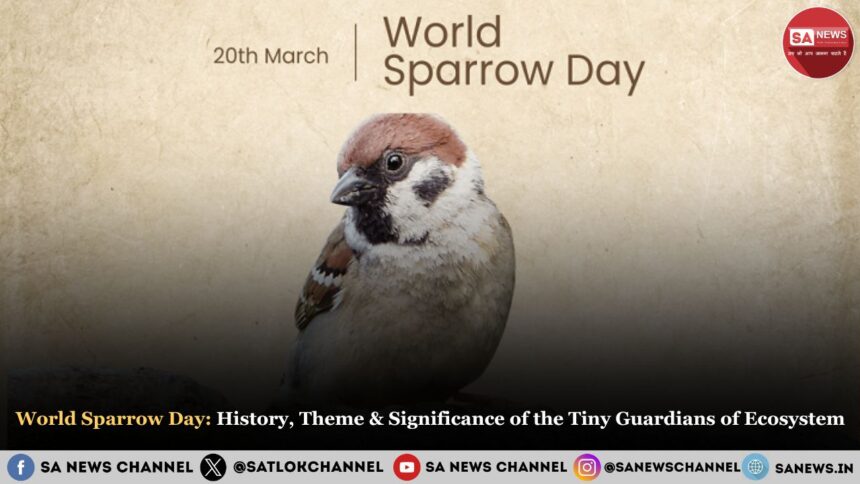On March 20, 2025, the global community unites to observe World Sparrow Day, an annual event dedicated to raising awareness about sparrows and the pressing need to safeguard these small yet vital birds. Initiated in 2010 by the Nature Forever Society of India, in partnership with the Eco-Sys Action Foundation of France and other international groups, this day shines a spotlight on the ecological importance of sparrows and the challenges they face amid a rapidly changing world.
Theme of World Sparrow Day 2025
The theme for this year, “A Tribute to Nature’s Tiny Messengers,” emphasizes:
- The importance of sparrows in ecosystems as pollinators and natural pest controllers.
- The urgent need to protect their habitats amidst rapid urbanization.
- The symbolic connection between sparrows and human life, reminding us of the delicate balance in nature.
Through this theme, conservationists urge communities, governments, and individuals to take action in preserving sparrow populations.
History of World Sparrow Day
World Sparrow Day, celebrated annually on March 20, was established to raise awareness about the declining populations of house sparrows and other common birds in urban environments. The initiative was spearheaded by the Nature Forever Society of India, founded by Indian conservationist Mohammed Dilawar, in collaboration with the Eco-Sys Action Foundation of France.
Key Milestones:
- 2008: Mohammed Dilawar was recognized as a “Hero of the Environment” by TIME magazine for his efforts in sparrow conservation.
- 2010: The inaugural World Sparrow Day was celebrated, featuring activities such as art competitions, awareness campaigns, and media interactions to promote the cause.
The Significance of Sparrows
Sparrows, particularly the house sparrow (Passer domesticus), have been integral to human environments for centuries. Their cheerful chirps once dominated both rural and urban soundscapes, making them familiar companions in our daily lives. Beyond their endearing presence, sparrows contribute to ecological balance by:
- Insect Control:
- Feeding on various insects and pests, they naturally regulate insect populations, benefiting agriculture and reducing the need for chemical pesticides.
- Seed Dispersal and Pollination:
- By consuming seeds and aiding in pollination, sparrows support plant biodiversity and the health of ecosystems.
- Environmental Indicators:
- As bioindicators, fluctuations in sparrow populations can signal changes in environmental health, alerting us to potential ecological issues.
Threats to Sparrow Populations
Despite their adaptability, sparrows are facing an unprecedented decline, driven by human-induced changes to their environment.
- Urban Challenges:
- Modern architecture, with its glass facades and sealed structures, eliminates traditional nesting sites.
- Electromagnetic radiation from mobile towers may interfere with their navigation and reproduction.
- Rural Pressures:
- Industrial farming reduces grain and insect availability, key food sources for sparrows.
- Pesticide use further depletes their diet, threatening their survival.
- Global Impact:
- Studies show some species, like the house sparrow (Passer domesticus), have declined by up to 70% in certain areas over recent decades.
■ Also Read: Biological Classification: Understanding the Diversity of Life
World Sparrow Day 2025: A Call to Action
With the theme as inspiration, global initiatives are turning awareness into tangible efforts to save sparrows and their ecosystems.
- Community Efforts:
- Birdwatching events, workshops, and nest-box installations are engaging people of all ages.
- In India, schools host art competitions and talks to inspire young conservationists.
- Innovative Projects:
- The UK’s “Sparrow Streets” initiative encourages residents to create sparrow-friendly neighborhoods with native plants and reduced pesticides.
- Citizen science programs in Europe and North America invite people to report sightings, aiding population research.
- Global Participation:
- Countries like Australia, South Africa, and Brazil see growing grassroots movements to protect local sparrow species.
Technology and Awareness
In 2025, technology amplifies the reach of World Sparrow Day, connecting people to the cause in new ways.
- Social Media Buzz:
- Hashtags like #WorldSparrowDay and #SaveTheSparrow trend as users share photos, videos, and personal stories.
- Digital Tools:
- Bird-tracking apps empower individuals to contribute to conservation from their homes.
- Documentaries and virtual reality experiences offer immersive insights into sparrow life, bridging urban-nature divides.
A Shared Responsibility
As World Sparrow Day 2025 draws to a close, its message lingers: the fate of sparrows rests in our hands. Simple actions can make a difference in their survival and, by extension, the health of our ecosystems.
- Everyday Steps:
- Plant native shrubs or trees to provide food and shelter.
- Avoid pesticides and offer water sources in gardens or balconies.
- Install nest boxes to replace lost habitats.
- Broader Impact:
- Protecting sparrows supports biodiversity, benefiting countless other species and strengthening ecosystems.
Sparrows may be small, but their presence—or absence—speaks volumes about the state of our planet.
A Harmonious Future for Sparrows and Humanity
As World Sparrow Day 2025 unfolds on March 20, it leaves us with a profound reminder of our interconnectedness with nature. The teachings of Sant Rampal Ji Maharaj also emphasizes living in harmony with nature and all living beings, resonate deeply with the ethos of World Sparrow Day. He advocates for a life of compassion, where humanity recognizes its duty to protect every creature as part of God’s creation.
According to his philosophy, all beings—down to the smallest sparrow—are manifestations of the Supreme Divine, deserving of care and respect. Sant Rampal Ji Maharaj teaches that true salvation and ecological balance stem from aligning our actions with spiritual wisdom, rejecting harm to nature, and fostering a sustainable existence. His message inspires us to see sparrow conservation not just as an environmental act, but as a spiritual responsibility—a way to honor the divine presence in all life forms.
By blending the practical efforts of World Sparrow Day—such as creating habitats and raising awareness—with the spiritual insights of Sant Rampal Ji Maharaj, we can forge a path toward a world where biodiversity and human well-being flourish together. Let this day be a stepping stone to a broader awakening, where protecting sparrows becomes a reflection of our commitment to a higher purpose, ensuring that nature’s tiny messengers continue to sing, and humanity finds peace in nurturing the planet we all share.







